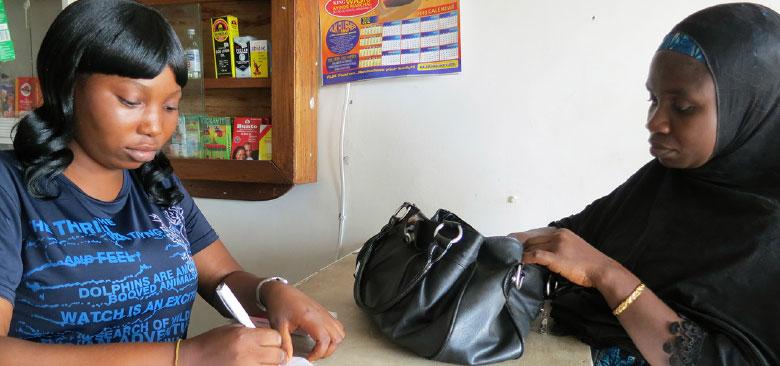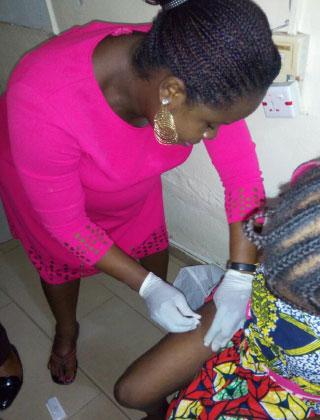
A drug shop worker counsels a customer (photo by Anna de la Cruz).
Can Economics-Informed Strategies Improve Health Care Access in Sub-Saharan Africa?
When economist Jenny Liu joined the faculty at UC San Francisco in 2015, she brought with her an unusual background in multidisciplinary work that focused on the intersection of economic development, demography and health. It made her a perfect fit with a growing research movement – one with deep roots at the UCSF School of Nursing – that approaches seemingly intractable health problems from what can be surprising angles.
Liu is now an assistant professor at the School’s Institute for Health & Aging (IHA), and her latest research in sub-Saharan Africa – a region that disproportionately bears the burden of sexually transmitted infections (STIs), including more than 70 percent of the world’s human immunodeficiency virus (HIV) infections – is a good example. There, Liu is testing innovative health service delivery schemes through private-sector distribution channels to help women in the region more easily and proactively access essential health products and services related to sexual and reproductive health (SRH).
“We need to think about robust and sustainable delivery platforms that can get necessary commodities to the right people at the right places, and at the right times,” says Liu.
Early Insights Inform Later Work
 Jenny Liu (photo by Elisabeth Fall) Liu initially joined UCSF in 2015, as part of Richard Feachem’s research team at the Institute for Global Health Sciences, working on malaria elimination and eradication. In particular, she focused on making rapid diagnostic tests (RDTs) for malaria more readily available to consumers in the part of the world – Africa; her pilot study was in Nigeria – that experiences the majority of malaria cases and deaths.
Jenny Liu (photo by Elisabeth Fall) Liu initially joined UCSF in 2015, as part of Richard Feachem’s research team at the Institute for Global Health Sciences, working on malaria elimination and eradication. In particular, she focused on making rapid diagnostic tests (RDTs) for malaria more readily available to consumers in the part of the world – Africa; her pilot study was in Nigeria – that experiences the majority of malaria cases and deaths.
Malaria RDTs are particularly important, says Liu, because it’s common for anyone who develops a fever in Nigeria to visit a local retail drugstore (known as a “drug shop” in Africa) to get over-the-counter antimalarial medication, regardless of whether they have been tested. Quick, accurate, point-of-service diagnosis can prevent those who aren’t infected from using antimalarial medications needlessly, which can contribute to drug resistance, a major concern in malaria-endemic regions. “One of our studies found that anything ranging from 70 to 90 percent of self-treated suspected malaria cases were being treated incorrectly,” says Liu.
Liu and her co-investigators tested an intervention that provided free, point-of-service RDTs and, depending on the results, treatment advice to anyone purchasing antimalarial medications from a retail drug shop. Half of the participants received text messages reiterating the diagnosis and advice. Four days later, they received a telephone call to assess their adherence to the prescribed regimen.
The investigators found that adherence was 14.3 percentage points higher among those who had received the text messages than among those who hadn’t, demonstrating the potential for a simple, cost-effective intervention that could easily be automated and incorporated into routine care to improve malaria treatment. The work convinced Liu that developing sustainable interventions depends on health workers and policymakers thinking beyond philanthropy and government-supported programs to leverage market-based solutions that are more economical and, she believes, can ultimately reach more people.
Getting Sexual and Reproductive Health Products to Girls in Tanzania
Liu is applying insights from her malaria project to her current work in Tanzania, a country where political and social attitudes can prevent girls and women from accessing the SRH products and services they need, says Liu. When they do seek out services, it’s often in reaction to an event – pregnancy or an HIV scare, for example – rather than for prevention.
“It’s not a friendly environment for girls, because they can’t escape scrutiny,” Liu says. “They have no privacy, no money and no resources. Random people in the street tell them what they can and can’t do, and teachers inspect their things.”
With funding in the form of a grant from the National Institute of Mental Health (NIMH), Liu is investigating ways to proactively connect girls with SRH products and services by using design thinking methods (borrowed from private-sector consumer marketing tools) to develop strategies that are salient and relevant to SRH products. The goal is to ameliorate prohibitive influences and create consumer demand that will, she hopes, increase access to important SRH products that adolescent girls can’t currently obtain easily, despite their need for preventive care.
After following a group of Tanzanian girls through their daily lives for several weeks, Liu and her co-investigators began developing interventions to get items like HIV self-tests and contraception – as well as links to care – into the hands of girls and young women, aged 15 to 24, via the country’s retail drug shops.
For example, Liu’s team is considering bundling SRH products and information with menstrual supplies or other products, like nail polish samples, perhaps offering “secret symbol” cards that the women can use to more discreetly gain access to SRH products and services. Loyalty programs and mystery prizes might also encourage the young women to seek out SRH products.
Using Behavioral Economics to Drive Change
For each of these potential strategies, Liu hopes to deploy methods from behavioral economics, which theorizes about how to drive buying behaviors by using stimuli and context to leverage individuals’ unconscious tendencies. “We’re looking at things like message framing, symbolism, colors and other cues – a lot of subtle things that work in concert to move girls from the reactive state to the preventive state.”
Liu and her co-investigators are holding focus groups to narrow down ideas and make iterative changes in both delivery and messaging. Over the next year, they will conduct a pilot evaluation of the most promising ideas.
Paving the Way for Better Contraception Access in Nigeria
 A Nigerian health worker injects a patient with DMPA-SC, a long-term contraceptive. In another major project, in Nigeria, where an estimated 16 percent to 22 percent of women lack access to needed contraceptives, Liu studies how subcutaneous depot medroxyprogesterone acetate (DMPA-SC), an injectable contraceptive that provides protection from pregnancy for three months, has been introduced and scaled up throughout the country. It has the potential to be an important option for women in low-resource settings because of its efficacy and ease of use (syringes are prefilled, and the medication is injected under the skin rather than into the muscle) compared with other long-term contraceptives.
A Nigerian health worker injects a patient with DMPA-SC, a long-term contraceptive. In another major project, in Nigeria, where an estimated 16 percent to 22 percent of women lack access to needed contraceptives, Liu studies how subcutaneous depot medroxyprogesterone acetate (DMPA-SC), an injectable contraceptive that provides protection from pregnancy for three months, has been introduced and scaled up throughout the country. It has the potential to be an important option for women in low-resource settings because of its efficacy and ease of use (syringes are prefilled, and the medication is injected under the skin rather than into the muscle) compared with other long-term contraceptives.
Liu’s research evaluated programs that used both public- and private-sector channels to make DMPA-SC available to women, looking at both uptake and users’ experiences. She found that women were more likely to continue using DMPA-SC after the initial injection when they received high-quality counseling, and that those who received DMPA-SC via public providers – largely via high-volume family planning facilities – tended to be older and married with children, while younger, unmarried users were less likely to seek out and use the product.
These findings provide evidence that reaching young, unmarried women – who are less likely to have access to effective, relatively long-term contraception – depends on finding distribution platforms, outside of traditional health facilities, that can deliver high-quality counseling.
Getting to Comprehensive SRH Care
Because of the massive need in sub-Saharan Africa, Liu also believes it’s critical that many SRH-related services be readily available in one place, at one time. “Unfortunately, a lot of SRH programs are very siloed,” she says. “You go somewhere that can only do one thing for you, but there are 10 other things you have questions about.”
To address the problem, she is beginning work on a five-year project in Zambia that provides an SRH curriculum that integrates sexual education with linkage to comprehensive care for girls and young women. Funded by the NIMH, Liu’s project partners with DREAMS (Determined, Resilient, Empowered, AIDS-free, Mentored, and Safe), a program of the United States President’s Emergency Plan for AIDS Relief (PEPFAR), and with a nongovernmental organization (NGO) called Grassroot Soccer, which provides girls in developing countries with mentoring and social support using sports-based activities, to deliver the curriculum.
“Not only are girls [in Zambia] shy about talking about SRH, but they’re often also excluded from sports, so it ticks a couple of boxes,” says Liu.
The curriculum will cover contraception, pregnancy, HIV and other STIs, and will connect girls with a comprehensive set of services, including pre-exposure prophylaxis (PrEP) for HIV, with testing and linkage to treatment for those who test positive, plus pregnancy care and treatment for other STIs.
Liu and her co-investigators will follow a cohort over two to three years to assess their health and well-being and to identify which interventions are most effective. The assessment will also include an economic evaluation to determine the most cost-effective pathway to sustaining and potentially expanding the most successful aspects of the program.
Creating Self-Sustaining Health Programs
For an economist like Liu, sustainability is a critical concept. Even if her innovations prove viable, the products and services must remain in the marketplace without subsidies or they will disappear.
“Right now, most global health products are highly subsidized and require a lot of external donor support to get into the market,” she says. “These products need to generate enough demand, so they can remain available and affordable over time.”



